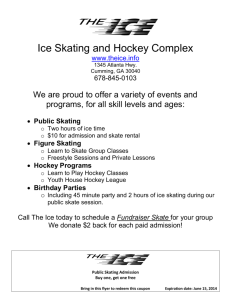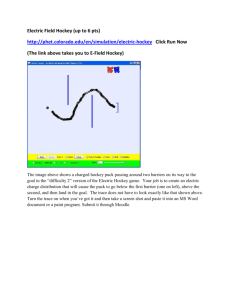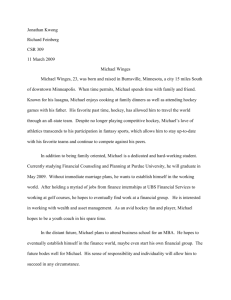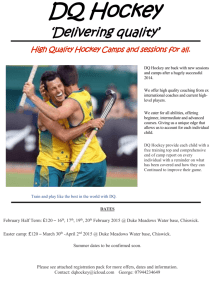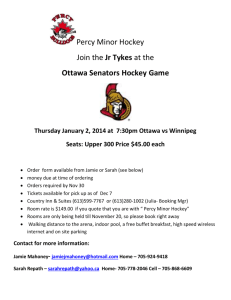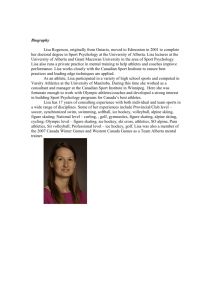USAmputeehockey-VOIGHT
advertisement
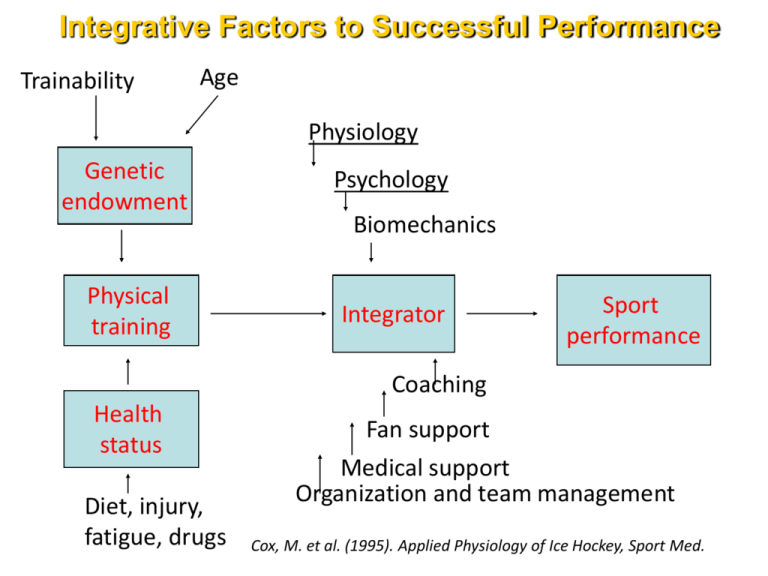
Integrative Factors to Successful Performance Trainability Age Physiology Genetic endowment Psychology Physical training Integrator Biomechanics Sport performance Coaching Health status Diet, injury, fatigue, drugs Fan support Medical support Organization and team management Cox, M. et al. (1995). Applied Physiology of Ice Hockey, Sport Med. Goals of the US Amputee Strength and Conditioning Program • Develop a high level of athleticism • Performance enhancement • Prevention of injury – Overuse, skin breakdowns, and joint pain inflammation to the non-amputated or amputated limbs Athleticism • Development of Total Athleticism – Agility – Balance – Coordination – Core stability – Endurance – Flexibility – Power – Reaction / Reflexes – Speed – Strength • Periodization for Ice Hockey – Strength – Power – Speed – Plyometrics – Metabolic training [aerobic and anaerobic] – Flexibility Endurance • Anaerobic endurance • Aerobic endurance – Cardiovascular efficiency – Muscular conditioning – Permits rapid recovery between intense periods of activity • Aerobic activities include: – Distance running – Distance skating – Bicycling – Slide-stride boards – Swimming – High intensity – Short duration • A player’s ability to repeat skills without exhaustion • Anaerobic activities include: – Skating intervals Strength • Specific muscle groups used in hockey – Upper body and core strength • Core strength (Abdominals, Lower Back, Hips) – Flexion, Rotation – Hyperextension/Extension – Stability/Physio Ball – Medicine Ball (2-5 kg) Power Training • Plyometrics [speed and agility] – Series of footwork drills to improve your balance, agility, endurance and vertical jump. You'll gain exceptional body awareness and the ability to move quickly and explosively in any direction • Strength Training – Involves the use of weight lifting with specialized equipment to improve your power base in key areas often neglected by traditional weight training, such as the core strength, lower abdominals and hip girdle • Resistance Training – Attached to your arms and/or legs, training cords increase resistance when you're running, skating, kicking, hitting or throwing and are used differently for each sport. – Training cords enable athletes to strengthen while performing the skill at velocities used in actual athletic competition Strength Exercises Typical To Hockey Sport Specific Training • What skating movements are required of a player? – Forward skating stride (Hip flexion, extension and abduction) – Backward skating stride (Hip flexion, extension, abduction, external rotation, knee extension) – Cross-over (Hip extension, adduction, and knee extension) In their own words …. “We live in a very competitive society. Participation in sports is a valid avenue for persons with disabilities to learn physical skills and socialization skills that will allow them to more effectively compete in all areas of their lives. Attitudes change when people observe other people breaking stereotypes and dispelling misconceptions.” - Duncan Wyeth, Paralympic champion in cycling, discus, & javelin “We are a group who tends to challenge life instead of waiting around for things to come to us. We are the high-profile ‘hot shots’ that help change the image of the physically challenged by our social appeal and appearance.” - Brenda Gilmore, National champion in tennis “The fact that I can’t run like others does not always put me at a disadvantage. It just means that I may have to train better and play more intelligently to compete on a level playing field. Maybe that’s what conquering a disability is all aboutfiguring out how to level the playing field.” - Rod Hernley, Paralympic champion in skiing “Sport can help you to accept a disability within a functional context, to overcome prejudices toward disability, and to form a self-confident identity.” - Gunther Belitz, Paralympics champion in track & field In their own words continued .. “I truly feel it is an honor to have the opportunity to wear Team USA jersey and represent other amputees in our country” -- Dave Levesque (US Hockey captain) “Our team personality should be as winners and we represent the United States of America - the best country in the world.” -- Joe Bowser (US Hockey player, Administrator for Army Secretary Pete Geren) Coaching-Consulting Athletes w/ Disabilities • Acute Psychological-Situational Differences between able-bodied players and US Amputee team * frustration over prosthetics * pain/blisters from prosthetics * mistakes due to faulty equipment * longer time to dress/time for adjustments * limited time together (social-task cohesion) * limited time on the ice due to $-time constraints * limited access to specific fitness programs & specialized equipment for training (DePauw & Gavron, 1995) * importance of safe contact (boards) & falling safely • “Coaching techniques & training regimes used with able-bodied athletes should be used as the basis for training and suggested modifications used only as needed. Further, athletes with disabilities should also be consulted for their firsthand knowledge of effective training” (p. 173, D & G) Coaching-Consulting Athletes w/ Disabilities • Empirical research comparing Athletes w/ disabilities with Able-bodied (Sherrill, 1990): – Similar iceberg profiles – Similar success-failure responses – Anxiety & self-concept measures • Similarities between able-bodied players and US Amputee members * drive to win – self motivation * competitors (the sport ethic) * importance of the “effects” of mental game • TEAM similarities: * camaraderie – sharing your experiences * typical team issues/challenges = curfew; parental issues; PT issues; personnel issues; lineup Performance Preparation Protocol I. Optimal Preparation for Camp II. Optimal Preparation for Individual Improvement, III. Optimal Execution in Practice & Games IV. Enhanced Coping w/ Practice-Game Adversity V. Captaining-Contributions-CohesionVI. Practice & Games Correspondence Debriefing/Action Review (AR) Dave Harackiewicz, Professor & Coach, CCSU & USA Hockey Contact: Mike Voight, Ph.D., CCSU & Team Consultant website: www.drmikevoight.com E: voightmir@ccsu.edu II. GOING FOR GOLD: 2008 NATIONAL CHAMPIONSHIPS ** choose one of these (or more), or one of your fav’s, write it down, and post it in your locker (T.E.A.M was used last night) "The harder the conflict, the more glorious the triumph." “It is a rough road that leads to the heights of greatness.” "Every job is a self-portrait of the person who did it. Autograph your work with excellence." "Go over, go under, go around, or go through. But never give up." "You measure the size of the accomplishment by the obstacles you had to overcome to reach your goals." Booker T. Washington "Obstacles are those frightful things you see when you take your eyes off your goals." "Adversity does not build character…it reveals it." "There is no challenge too great for those who have the will and heart to make it happen." "Courageous risks help you grow, allow you to face your fears, and make you better than you think you are." "Excellence is never an accident; it is the result of high intention, sincere effort, intelligent direction, skillful execution and the vision to see obstacles as opportunities" -------------------------------------------------------------------------------** all the best in your preparations for the GOLD ! III. Individual Improvement: Contributions Inspiration Emotional Toughness Mental ToughnessMechanics Leadership Quality Practice Team Play Knowledge of Tactics Technical Proficiency Physical Toughness III. MENTAL SKILLS TRAINING for HOCKEY ON-ICE MENTAL TOUGHNESS ROUTINES Routine/Cues Active hands Mental skill/action = spinning the stick = active stick on the ice Mental/Technical Effect > release tension; present focus; increase energy; refocusing; keeping hands ready Energizing breaths = full breaths > fend off tension & fatigue; energize system Active feet = keep skating > alleviates watching play; present focus; improve readiness & anticipation Focus below the glass = focus on ice & boards > focusing IN on present action, not on distractions off-ice (stands, scoreboard) 'Park' distractions = refocus; present focus > mistake management; dealing w/ distractions, stressors; adversity Refocusing routines: Strategy/Toughness Cues = refocus; present focus > readiness; confidence enhancement; mistake management. Head on a swivel cue = strategy/toughness cue; widen attentional focus > increase vision; improved reads & position; communication; readiness. Performance cues (the A-B-C's) = present focus; focus on specific roles > concentration; refocusing; confidence; mistake management; mastering adversity
